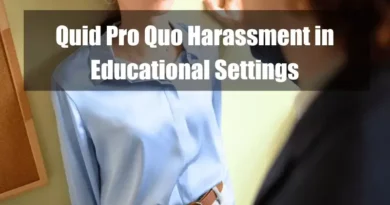Fear and Silence in Quid Pro Quo Harassment
Fear and silence in quid pro quo harassment are tightly linked, driven by the power imbalance between harasser and victim. Victims often fear retaliation or negative impacts on their careers or educational opportunities if they refuse the harasser’s demands.
This fear intensifies with the psychological effects of harassment, leading to anxiety, depression, and a sense of powerlessness. The culture within an organization can amplify this silence, particularly in settings lacking supportive policies or clear reporting mechanisms.
Effective legal and organizational measures are vital to breaking this cycle of fear and silence, ensuring victims feel safe to speak out without fearing retribution.
Takeaways
| Key Points |
|---|
| Quid pro quo harassment is a form of sexual harassment where individuals in power demand sexual favors in exchange for workplace benefits, such as promotions or job security, making it both unethical and illegal under Title VII of the Civil Rights Act of 1964. |
| Fear and silence often dominate such cases, as victims fear retaliation, psychological trauma, and professional repercussions, which prevent them from reporting the abuse. |
| Power imbalances are central to this harassment, with those in authority exploiting their positions to coerce victims, often seen in workplace or educational settings where promotions or grades are tied to compliance. |
| The impact on victims extends beyond stalled careers to emotional distress, anxiety, depression, and long-term psychological effects like PTSD, all exacerbated by organizational cultures that may dismiss or trivialize such behavior. |
| To combat this, organizations and legal systems must enforce robust anti-harassment policies, foster transparent reporting mechanisms, and create supportive environments to empower victims and dismantle the culture of silence. |
Introduction
Definition of Quid Pro Quo Harassment
quid pro quo harassment is a form of sexual harassment that occurs when an individual in a position of power demands sexual favors in exchange for workplace benefits, such as promotions, raises, or continued employment.
This type of harassment is not just unethical but also illegal under Title VII of the Civil Rights Act of 1964, which prohibits employment discrimination based on sex. The key element of quid pro quo harassment is the implicit or explicit promise of job-related benefits contingent upon submission to sexual advances.
Relevance of Fear and Silence in the Context
Fear and silence are prevalent in quid pro quo harassment cases, significantly affecting the victims’ ability to report the abuse. Victims often fear retaliation, such as job loss or demotion, which can lead to a toxic work environment where harassment goes unreported and unaddressed.
This fear is compounded by the psychological trauma of the harassment itself, making it difficult for victims to come forward. Understanding the dynamics of fear and silence in these situations is crucial for creating effective policies and support systems to protect victims and ensure a safe workplace.
Power Dynamics in Quid Pro Quo Harassment

Understanding Power Imbalances
Power imbalances are at the core of quid pro quo harassment. The harasser typically holds a position of authority over the victim, such as a supervisor or manager, which allows them to influence the victim’s employment status.
This power differential creates a situation where the victim feels compelled to comply with the harasser’s demands out of fear of losing their job or facing other negative consequences. The harasser exploits this power to coerce the victim, knowing that their authority can intimidate the victim into silence.
Examples of Power Abuse in Workplace and Educational Settings
In workplace settings, power abuse can manifest in various forms. For instance, a manager might promise an employee a promotion in exchange for sexual favors or threaten to terminate their employment if they refuse.
Similarly, in educational settings, professors or administrators might offer better grades or recommendations in exchange for sexual compliance. These abuses of power are not only unethical but also violate federal laws designed to protect employees and students from discrimination and harassment.
Impact on Victims’ Career and Personal Life
The impact of quid pro quo harassment on victims can be devastating. Professionally, victims may find their career progression stalled or sabotaged if they refuse to comply with the harasser’s demands. This can result in lost opportunities for advancement, salary increases, and professional development.
Personally, the harassment can lead to severe emotional distress, including anxiety, depression, and a loss of self-esteem. The fear of retaliation and the trauma of the harassment can also spill over into the victims’ personal lives, affecting their relationships and overall well-being.
Psychological Impact of Fear and Silence

Anxiety and Depression Induced by Harassment
Quid pro quo harassment often induces significant psychological distress. Victims may experience anxiety, constantly worrying about potential retaliation or further harassment. This anxiety can be debilitating, affecting their ability to perform their job and interact with colleagues.
Depression is also common among victims, stemming from feelings of helplessness and powerlessness. The constant fear and stress can lead to a persistent state of emotional turmoil, making it difficult for victims to find joy in their personal and professional lives.
Long-term Psychological Effects
The long-term psychological effects of quid pro quo harassment can be severe. Many victims have post-traumatic stress disorder (PTSD), characterized by flashbacks, nightmares, and severe anxiety related to the harassment. This can lead to long-term mental health issues that require professional treatment.
Additionally, the stigma and shame associated with harassment can cause victims to isolate themselves, further exacerbating their mental health problems. The enduring impact of these psychological scars underscores the need for effective support and intervention strategies.
Organizational Culture and Silence

How Organizational Culture Can Silence Victims
Organizational culture plays a crucial role in either fostering or mitigating silence around quid pro quo harassment. In environments where harassment is ignored or trivialized, victims are less likely to report incidents due to fear of not being believed or facing retaliation.
A culture prioritizing productivity over employee well-being can further silence victims, who may feel that their complaints will be dismissed as distractions. Organizations that lack clear policies and procedures for addressing harassment contribute to a culture of silence, where victims feel unsupported and vulnerable.
Role of Management and Leadership
Management and leadership are pivotal in shaping the organizational culture regarding harassment. Leaders who take a strong stance against harassment and actively promote a safe and inclusive workplace can create an environment where victims feel empowered to speak up.
Conversely, leaders who ignore complaints or engage in harassment set a damaging precedent discouraging reporting. Effective leadership involves establishing clear anti-harassment policies and enforcing them consistently and fairly.
Training programs for managers and employees can help create a more supportive environment.
Barriers to Reporting Harassment
Fear of Retaliation and Job Loss

One of the most significant barriers to reporting quid pro quo harassment is the fear of retaliation. Victims often worry that speaking up will lead to job loss, demotion, or other adverse consequences. This fear is not unfounded; numerous cases have shown that victims who report harassment often face some form of retribution.
For example, the Equal Employment Opportunity Commission (EEOC) reports that retaliation is the most frequently cited issue in workplace discrimination complaints, accounting for 55.8% of all charges filed in 2020. The potential for economic hardship, coupled with the emotional strain of confronting the harasser, creates a formidable obstacle to reporting.
Lack of Trust in Reporting Systems
Many victims do not trust the reporting mechanisms in place at their organizations. This distrust can stem from previous experiences where complaints were ignored or mishandled.
In some cases, victims have seen colleagues who reported harassment face negative outcomes, which further erodes confidence in the system. Effective reporting systems must be transparent, impartial, and consistently applied to gain employees’ trust.
According to a Harvard Business Review article, only 30% of employees facing harassment made internal complaints, and less than 15% filed formal legal charges. This low reporting rate is due to fears of retaliation, inflexibility of reporting options, and a hostile work environment where reports may be ignored or lead to backlash.
Stigma and Social Consequences
The stigma associated with being a harassment victim also plays a significant role in the silence surrounding quid pro quo harassment. Victims often fear being labeled as troublemakers or not being believed, which can lead to social ostracism within the workplace.
This stigma can be particularly pronounced in industries or environments where such behavior is normalized or trivialized. The social consequences of reporting harassment can be as damaging as the professional ones, contributing to a pervasive culture of silence.

Legal and Institutional Responses
Overview of Relevant Laws and Regulations
Title VII of the Civil Rights Act of 1964 is the cornerstone of U.S. anti-discrimination law, prohibiting employment discrimination based on race, color, religion, sex, and national origin. Quid pro quo harassment is explicitly addressed under this statute, making it illegal for employers to condition employment benefits on sexual favors.
The Equal Employment Opportunity Commission (EEOC) enforces these laws and provides guidelines for identifying and addressing harassment in the workplace.
Institutional Mechanisms to Address Fear and Silence
Institutions must develop effective mechanisms to address fear and silence in harassment cases. This includes establishing clear anti-harassment policies, providing multiple reporting avenues, and ensuring confidentiality throughout the investigation.
Institutions should also train managers and employees to recognize and respond to harassment. Regularly reviewing and updating policies helps maintain their effectiveness.
The EEOC recommends proactive steps to prevent harassment, such as conducting climate surveys and fostering a culture of accountability.
Support Systems and Resources for Victims

Importance of Counseling and Mental Health Services
Counseling and mental health services are crucial for victims of quid pro quo harassment. These services provide a safe space for victims to process their experiences and receive professional support.
Counseling helps victims manage the psychological effects of harassment, such as anxiety, depression, and PTSD. Access to mental health services is a vital component of an organization’s support system, aiding victims in their recovery and well-being.
Role of Employee Assistance Programs (EAPs)
Employee Assistance Programs (EAPs) are significant in supporting victims of harassment. EAPs offer confidential counseling, referral services, and support for employees facing personal or work-related issues.
These programs provide immediate assistance to victims, helping them navigate the aftermath of harassment. EAPs can also educate employees about their rights and available resources, empowering them to take action against harassment.
According to the U.S. Department of Health and Human Services, EAPs effectively address various issues, including workplace harassment.
Preventive Measures and Solutions
Developing Clear Anti-Harassment Policies
Clear anti-harassment policies are essential for preventing quid pro quo harassment. These policies should define harassment, outline the procedures for reporting and investigating complaints, and specify the consequences for violators. Policies must be communicated to all employees and enforced consistently.
Regular training sessions reinforce these policies and ensure employees understand their rights and responsibilities. The Society for Human Resource Management (SHRM) emphasizes the importance of well-drafted policies accessible to all employees.
Importance of Training and Awareness Programs
Training and awareness programs are critical in preventing harassment and promoting a respectful workplace culture. These programs should educate employees about the different forms of harassment, how to recognize it, and how to respond.
Training should also emphasize the organization’s commitment to a harassment-free workplace and encourage employees to report incidents. Interactive training sessions, including role-playing scenarios, can be particularly effective in helping employees understand and apply the concepts learned.
Creating a Supportive Environment for Reporting
Creating a supportive environment for reporting harassment is vital. This involves building a culture where employees feel safe and supported in coming forward with their complaints. Organizations should provide multiple confidential channels for reporting harassment, such as hotlines, online reporting systems, and designated human resources personnel.
Ensuring that reports are taken seriously and investigated promptly helps build trust in the reporting system. Organizations should also protect employees from retaliation and provide updates on the status of their complaints to maintain transparency.
Conclusion
Addressing fear and silence in quid pro quo harassment requires a multifaceted approach. By understanding the power dynamics at play, recognizing the psychological impact on victims, and fostering a supportive organizational culture, we can create environments where victims feel empowered to speak out.
Legal frameworks and institutional mechanisms must be robust and responsive, providing clear policies, effective reporting systems, and comprehensive support for victims. Preventive measures, including training and awareness programs, are essential to cultivate a culture of respect and accountability.
Ultimately, addressing quid pro quo harassment not only protects individuals but also strengthens the integrity and productivity of organizations.
This comprehensive approach underscores the critical need for vigilance, support, and proactive measures in combating quid pro quo harassment.
FAQ
What is Quid Pro Quo Harassment, and how does it foster fear and silence?
Quid pro quo harassment refers to situations where an authority figure conditions employment benefits or advancement on the submission of sexual or other improper favors. This dynamic creates an environment where fear is leveraged as a tool to suppress dissent, as victims are acutely aware that resisting may jeopardize their job security. The inherent power imbalance not only pressures the targeted individual to comply but also induces a pervasive silence among peers who witness the behavior yet fear similar repercussions.
What is Fear-Based Intimidation in the context of quid pro quo harassment?
Fear-based intimidation is a tactic used by perpetrators to instill anxiety and apprehension in potential targets. In quid pro quo situations, this method involves implicit or overt threats that suggest negative consequences—such as demotion or termination—if the victim refuses to comply. The resulting climate of dread discourages open communication and reporting, ensuring that the harassing behavior remains unchallenged within the organization.
How do Silence Enforcement Tactics operate in quid pro quo harassment scenarios?
Silence enforcement tactics are deliberate strategies designed to keep victims and witnesses from speaking out. This can include subtle cues, direct orders, or the creation of policies that discourage discussion about inappropriate behavior. In environments marked by quid pro quo harassment, these tactics reinforce the idea that voicing concerns is risky, thereby ensuring that harassment persists while simultaneously isolating the victim and discouraging any collective response.
What are Coercive Authority Dynamics and their impact on victim silence in harassment cases?
Coercive authority dynamics occur when someone in a position of power exploits their status to compel compliance through the threat of negative consequences. In quid pro quo harassment, this misuse of authority creates a formidable barrier to challenging behavior because victims may feel that their dissent could be interpreted as insubordination or even lead to severe career repercussions. This imbalance not only suppresses individual agency but also perpetuates an organizational culture where silence is the norm.
How does Psychological Coercion manifest in quid pro quo harassment and contribute to a climate of silence?
Psychological coercion involves manipulating an individual’s emotions and perceptions to force compliance without overt physical threats. In quid pro quo scenarios, this can include subtle messaging that instills self-doubt and fear of failure. The mental strain imposed by such tactics often leaves victims feeling trapped, leading them to avoid confrontation or reporting. This emotional manipulation effectively silences individuals, reinforcing a cycle where harassment remains hidden and unaddressed.
What role do Organizational Suppression Mechanisms play in maintaining a culture of fear in harassment cases?
Organizational suppression mechanisms refer to the systemic practices and policies that discourage reporting and discussing harassment incidents. These may include opaque grievance procedures, lack of support from leadership, or even punitive measures against those who speak out. In quid pro quo harassment contexts, such mechanisms are instrumental in sustaining an environment of fear, where employees feel that any attempt to challenge the status quo will result in personal and professional harm, thus keeping the issue under wraps.
What is Retaliatory Silence, and how does it perpetuate quid pro quo harassment?
Retaliatory silence is the phenomenon where victims or witnesses choose not to report or discuss incidents of harassment due to fear of subsequent reprisal. This silence is often a calculated response to a climate where previous complaints have led to punitive actions, such as further marginalization or career setbacks. In quid pro quo cases, the threat of retaliation reinforces the harasser’s power, ensuring that the cycle of misconduct continues unchallenged.
What constitutes a Culture of Fear in the workplace regarding quid pro quo harassment?
A culture of fear in the workplace is characterized by an environment where employees consistently anticipate negative outcomes if they challenge established power structures or report misconduct. In cases of quid pro quo harassment, this culture is cultivated by repeated incidents of abuse, silence enforcement, and punitive responses to complaints. Such a climate stifles open dialogue, reduces trust in organizational leadership, and ultimately allows harassment to flourish unchecked.
What is Reporting Inhibition, and how does it affect the resolution of quid pro quo harassment?
Reporting inhibition refers to the barriers that prevent individuals from coming forward with allegations of harassment. These barriers may be psychological—stemming from fear of retaliation—or institutional, such as ineffective reporting channels and a lack of confidentiality. In quid pro quo situations, the perceived risk of speaking out discourages timely and accurate reporting, thereby hindering effective investigation and resolution and allowing the abusive dynamic to persist.
How does Inhibited Communication affect the prevalence of quid pro quo harassment?
Inhibited communication occurs when employees refrain from discussing issues or voicing concerns due to a fear of negative repercussions. In a quid pro quo harassment context, this suppression of dialogue means that problematic behavior is less likely to be challenged or remedied. The resulting lack of transparency creates an environment where misconduct can continue without scrutiny, further isolating victims and perpetuating the cycle of silence.
What does the Suppression of Dissent mean in the framework of quid pro quo harassment?
The suppression of dissent involves actively discouraging or silencing any opposition to established authority or behavior patterns. In the realm of quid pro quo harassment, this suppression is achieved through both formal policies and informal practices that label dissent as disruptive or disloyal. By stifling criticism, organizations inadvertently protect perpetrators and reinforce the notion that compliance is the safest route, thereby deepening employees’ sense of isolation and fear.
What are Unspoken Norms, and how do they contribute to fear and silence in harassment cases?
Unspoken norms are the implicit, often unacknowledged expectations and behavioral rules that govern acceptable conduct within an organization. In environments where quid pro quo harassment occurs, these norms can dictate that challenging a superior’s actions is taboo or that complaining may lead to social or professional ostracism. Such unwritten rules not only normalize the abusive behavior but also reinforce a climate where fear and silence are seen as the safest, albeit unjust, response.
How do Implicit Threats function in quid pro quo harassment environments?
Implicit threats are subtle, non-explicit signals that imply adverse outcomes should the victim resist or report inappropriate behavior. In quid pro quo harassment, these threats may be conveyed through tone, body language, or veiled comments that suggest severe career consequences. The ambiguity of these threats makes them particularly insidious, as victims often feel compelled to comply to avoid potential harm, all while remaining unsure about the exact nature of the promised retaliation.
What is power asymmetry exploitation and its role in quid pro quo harassment?
Power asymmetry exploitation refers to deliberately using an unequal power relationship to manipulate and control another individual. In quid pro quo harassment, supervisors or decision-makers leverage their superior position to demand favors or compliance under the threat of negative outcomes. This exploitation not only underpins the harassment but also reinforces a system in which victims are rendered voiceless, creating a self-sustaining cycle of abuse and silence that is difficult to break.
How does Self-Censorship in Harassment Contexts affect workplace dynamics in quid pro quo situations?
Self-censorship occurs when individuals voluntarily withhold their opinions or reports of misconduct due to an internalized fear of consequences. In the context of quid pro quo harassment, this phenomenon is driven by the anticipation of retaliation and the internalization of organizational messages that discourage dissent. As employees choose to remain silent, the overall workplace dynamic becomes increasingly skewed in favor of those in power, perpetuating the cycle of harassment and stifling any attempts at accountability or change.









